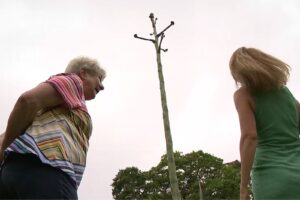The captivating allure of the Peruvian Apple Cactus, known scientifically as Echinopsis pachanoi, extends well beyond its striking appearance. This species is not only celebrated for its aesthetic qualities in the realm of horticulture but also for its psychoactive properties, which have drawn the attention of enthusiasts and researchers alike. As we delve into the potential hallucinations associated with this cactus, it is paramount to consider both the experiences it may elicit and the associated risks involved in its consumption.
Originating from the Andean mountain ranges, the Peruvian Apple Cactus has been used for centuries in traditional healing and religious ceremonies by indigenous cultures. The psychoactive component primarily responsible for its hallucinogenic effects is mescaline, a naturally occurring phenethylamine. This compound alters perception, mood, and cognitive processes when ingested, prompting vivid visual and auditory hallucinations. However, comprehending how these alterations manifest requires an exploration of the cactus’s intrinsic characteristics and the historical context of its use.
A multitude of factors influence the psychotropic experience, including individual physiology, dosage, and the environmental setting in which the cactus is consumed. Understanding these variables can help potential users approach the Peruvian Apple Cactus with caution and insight.
Examining the Varied Hallucinogenic Experiences
The mescaline experience can vary enormously from person to person. Some users report profound spiritual encounters, where they feel an interconnectedness with nature and the universe. These revelatory moments can foster a sense of clarity or personal insight that extends beyond the session. Additionally, users often describe vivid visual phenomena, such as enhanced colors, geometric patterns, and alterations in spatial perception. Auditory perceptions may also change, sometimes leading to a heightened appreciation for music or sounds in the environment.
In contrast, the ambiguous nature of hallucinogenic experiences also presents the potential for negative encounters. Some individuals may encounter anxiety, paranoia, or even frightening hallucinations. These adverse reactions can stem from factors such as prior psychological conditions, erroneous expectations, or an unsupportive environment during the experience. Therefore, it is essential for those considering the decision to use the Peruvian Apple Cactus to prepare adequately and understand the mental and emotional landscapes they may traverse.
Navigating the Risks Involved
While the allure of hallucinogenic experiences is undeniable, the consumption of the Peruvian Apple Cactus is not without its inherent risks. Beyond the psychological turbulence some users may experience, there are physical health concerns associated with ingestion. For instance, the cactus contains alkaloids that can provoke gastrointestinal discomfort, vomiting, and diarrhea, which may detract from the overall experience. These effects can occur even with small dosages, underscoring the necessity of careful handling and preparation of the cactus.
Moreover, there can be legal ramifications depending on jurisdiction. In many countries, mescaline and its sources are categorized as controlled substances. Engaging with the Peruvian Apple Cactus can lead to legal complications, making it paramount for potential users to research local laws governing its use and possession.
Moreover, pre-existing mental health conditions can significantly influence the effects of mescaline. Individuals with a history of psychotic disorders or severe anxiety may find that the experience exacerbates their symptoms. Due diligence in assessing personal mental health and seeking professional guidance is advisable before embarking on a journey with this potent cactus.
Understanding Preparation and Consumption
For those who decide to explore the hallucinogenic properties of the Peruvian Apple Cactus, knowing how to properly prepare and consume this plant is crucial. The cactus is typically harvested as a cutting, and various methods exist to extract the desired psychoactive compounds. One common procedure involves removing the outer skin and spines, slicing the flesh into small pieces, and boiling them to create a potent tea. This tea can then be consumed directly, often accompanied by traditional ceremonial practices to enhance the experience.
Alternatively, some users may opt for a dried form of the cactus, which can be ground into a powder and encapsulated or brewed. The dosage is a key element to consider; beginners are usually advised to start with a minimal amount to gauge their sensitivity. The onset of effects can range from 30 minutes to several hours, further reiterating the importance of patience and a calm environment during consumption.
Exploring the Cultural Context
From ancient practices to contemporary ceremonies, the Peruvian Apple Cactus occupies a significant space within cultural rituals. Its use among indigenous peoples demonstrates a rich tapestry of spiritual beliefs surrounding its powers. The cactus serves as a conduit for connecting with ancestral spirits, revealing the deep-rooted connections between plant life and human spirituality. In modern contexts, this tradition has evolved, with some users seeking psychedelic experiences for therapeutic benefits, including personal development and emotional healing.
While the therapeutic benefits of mescaline are being increasingly recognized in clinical settings, it is crucial to note that these applications should be approached with caution and respect for traditional practices. Engaging in such rituals without appropriate guidance may undermine the sanctity of the experience that indigenous cultures have long revered.
In conclusion, the exploration of hallucinations associated with the Peruvian Apple Cactus encompasses a myriad of experiences, risks, and cultural histories. As the interest in this cactus continues to grow, it becomes imperative for users to engage with it thoughtfully, prioritizing safety, preparation, and respect for its profound roots in human tradition. Whether one seeks mystical connections or therapeutic healing, understanding the multifaceted nature of this cactus can enhance one’s exploration of its astounding psychotropic potential.





Leave a Comment